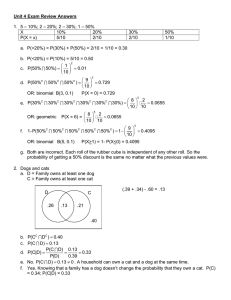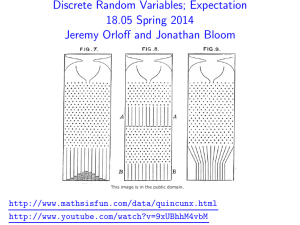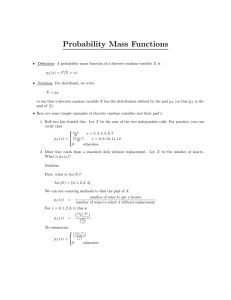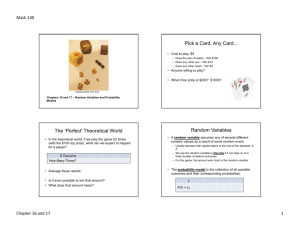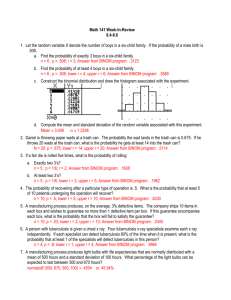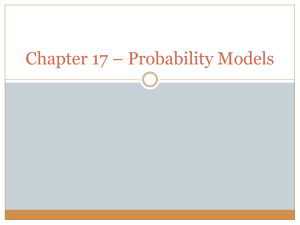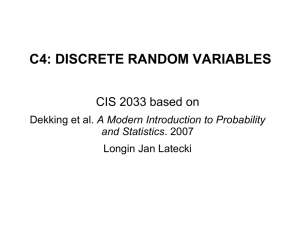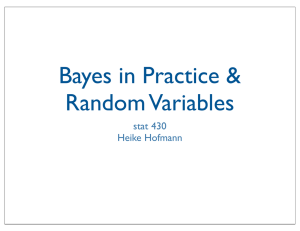Document 13436895
advertisement
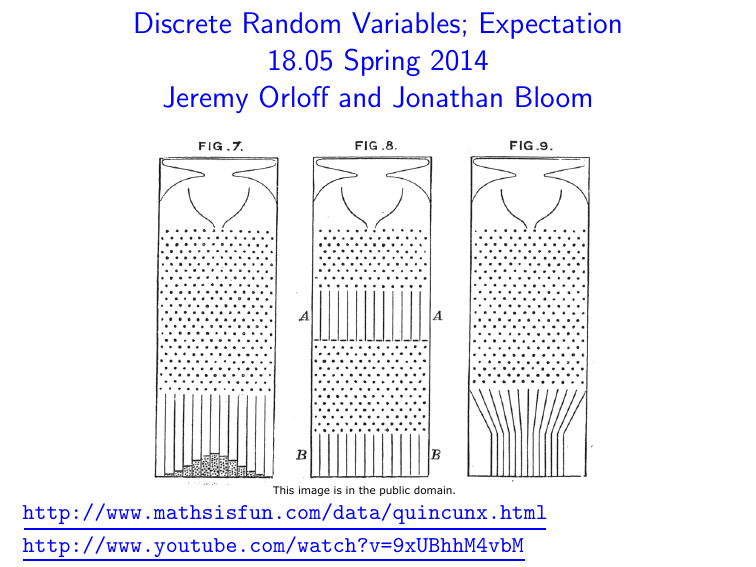
Discrete Random Variables; Expectation
18.05 Spring 2014
Jeremy Orloff and Jonathan Bloom
This image is in the public domain.
http://www.mathsisfun.com/data/quincunx.html
http://www.youtube.com/watch?v=9xUBhhM4vbM
Board Question: Evil Squirrels
One million squirrels, of which 100 are pure evil!
Events: E = evil, G = good, A = alarm sounds
Accuracy: P(A|E ) = .99, P(A|G ) = .01.
a) A squirrel sets off the alarm, what is the probability that it is evil?
b) Is the system of practical use?
answer: a) Let E be the event that a squirrel is evil. Let A be the
event that the alarm goes off. By Bayes Theorem, we have:
P(A | E )P(E )
P(E | A) =
P(A | E )P(E ) + P(A | E c )P(E c )
100
.99 1000000
=
100
999900
.99 1000000
+ .01 1000000
≈ .01.
b) No. The alarm would be more trouble than its worth, since for
every true positive there are about 99 false positives.
May 27, 2014
2 / 17
Big point
Evil
Nice
Alarm
99
9999
10098
No alarm
1 989901 989902
100 999900 1000000
Summary:
Probability a random test is correct =
99+989901
1000000
Probability a positive test is correct =
99
10098
= .99
≈ .01
These probabilities are not the same!
May 27, 2014
3 / 17
Table Question: Dice Game
1
2
3
The Randomizer holds the 6-sided die in one fist and
the 8-sided die in the other.
The Roller selects one of the Randomizer’s fists and
covertly takes the die.
The Roller rolls the die in secret and reports the result
to the table.
Given the reported number, what is the probability that
the 6-sided die was chosen?
May 27, 2014
4 / 17
Reading Review
Random variable X assigns a number to each outcome:
X :Ω→R
“X = a” denotes the event {ω | X (ω) = a}.
Probability mass function (pmf) of X is given by
p(a) = P(X = a).
Cumulative distribution function (cdf) of X is given by
F (a) = P(X ≤ a).
May 27, 2014
5 / 17
Concept Question: cdf and pmf
X a random variable.
values of X : 1 3 5 7
cdf F (a): .5 .75 .9 1
1. What is P(X ≤ 3)?
a) .15
b) .25
c) .5
d) .75
2. What is P(X = 3)
a) .15 b) .25 c) .5
d) .75
May 27, 2014
6 / 17
CDF and PMF
1
.9
.75
F (a)
.5
a
1
3
5
7
1
3
5
7
p(a)
.5
.25
.15
a
May 27, 2014
7 / 17
Deluge of discrete distributions
Bernoulli(p) = 1 (success) with probability p,
0 (failure) with probability 1 − p.
In more neutral language:
Bernoulli(p) = 1 (heads) with probability p,
0 (tails) with probability 1 − p.
Binomial(n,p) = # of successes in n independent
Bernoulli(p) trials.
Geometric(p) = # of tails before first heads in a
sequence of indep. Bernoulli(p) trials.
(Neutral language avoids confusing whether we want the number of
successes before the first failure or vice versa.)
May 27, 2014
8 / 17
Concept Question
1. Let X ∼ binom(n, p) and Y ∼ binom(m, p) be
independent. Then X + Y follows:
a) binom(n + m, p)
b) binom(nm, p)
c) binom(n + m, 2p)
d) other
2. Let X ∼ binom(n, p) and Z ∼ binom(n, q) be
independent. Then X + Z follows:
a) binom(n, p + q)
b) binom(n, pq)
c) binom(2n, p + q)
d) other
May 27, 2014
9 / 17
Board Question: Find the pmf
X = # of successes before the second failure of a
sequence of independent Bernoulli(p) trials.
Describe the pmf of X .
May 27, 2014
10 / 17
Dice simulation: geometric(1/4)
Roll the 4-sided die repeatedly until you roll a 1.
Click in X = # of rolls BEFORE the 1.
(If X is 9 or more click 9.)
Example: If you roll (3, 4, 2, 3, 1) then click in 4.
Example: If you roll (1) then click 0.
May 27, 2014
11 / 17
Fiction
Gambler’s fallacy: [roulette] if black comes up several
times in a row then the next spin is more likely to be red.
Hot hand: NBA players get ‘hot’.
May 27, 2014
12 / 17
Fact
P(red) remains the same.
The roulette wheel has no memory. (Monte Carlo, 1913).
The data show that player who has made 5 shots in a row
is no more likely than usual to make the next shot.
May 27, 2014
13 / 17
Memory
Show that Geometric(p) is memoryless, i.e.
P(X = n + k | X ≥ n) = P(X = k)
Explain why we call this memoryless.
May 27, 2014
14 / 17
Computing expected value
Definition:
E (X ) =
�
xi p(xi )
i
1. E (aX + b) = aE (X ) + b
2. E (X + Y ) = E (X ) + E (Y )
3. E (h(X )) =
�
h(xi ) p(xi )
i
May 27, 2014
15 / 17
Board Question: Interpreting Expectation
a) Would you accept a gamble that offers a 10% chance
to win $95 and a 90% chance of losing $5?
b) Would you pay $5 to participate in a lottery that offers
a 10% percent chance to win $100 and a 90% chance to
win nothing?
• Find the expected value of your change in assets in each
case?
May 27, 2014
16 / 17
Board Question
Suppose (hypothetically!) that everyone at your table got
up, ran around the room, and sat back down randomly
(i.e., all seating arrangements are equally likely).
What is the expected value of the number of people
sitting in their original seat?
(We will explore this with simulations in Friday Studio.)
May 27, 2014
17 / 17
MIT OpenCourseWare
http://ocw.mit.edu
18.05 Introduction to Probability and Statistics
Spring 2014
For information about citing these materials or our Terms of Use, visit: http://ocw.mit.edu/terms.
